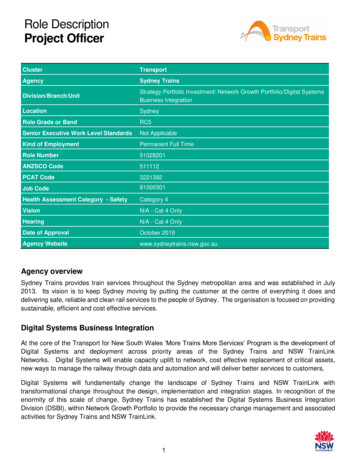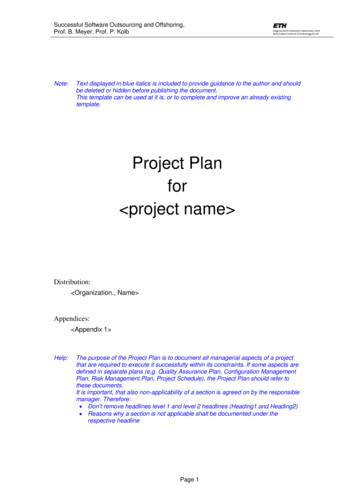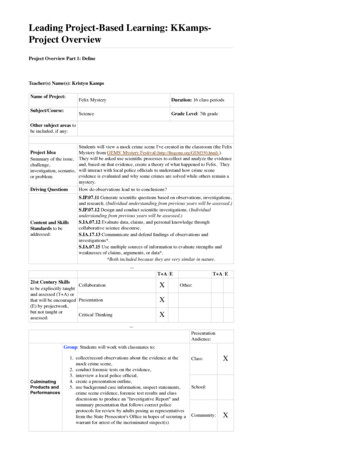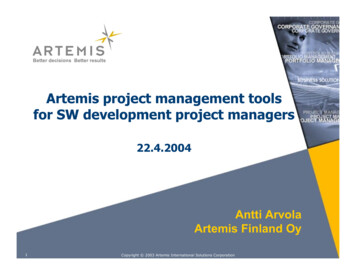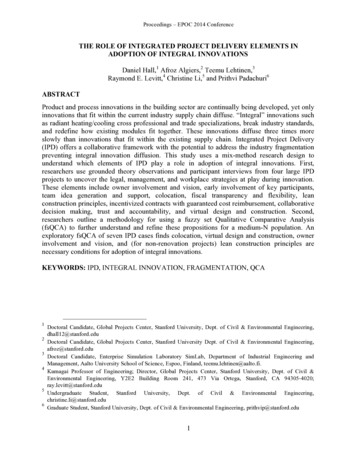
Transcription
Proceedings – EPOC 2014 ConferenceTHE ROLE OF INTEGRATED PROJECT DELIVERY ELEMENTS INADOPTION OF INTEGRAL INNOVATIONSDaniel Hall,1 Afroz Algiers,2 Teemu Lehtinen,3Raymond E. Levitt,4 Christine Li,5 and Prithvi Padachuri6ABSTRACTProduct and process innovations in the building sector are continually being developed, yet onlyinnovations that fit within the current industry supply chain diffuse. “Integral” innovations suchas radiant heating/cooling cross professional and trade specializations, break industry standards,and redefine how existing modules fit together. These innovations diffuse three times moreslowly than innovations that fit within the existing supply chain. Integrated Project Delivery(IPD) offers a collaborative framework with the potential to address the industry fragmentationpreventing integral innovation diffusion. This study uses a mix-method research design tounderstand which elements of IPD play a role in adoption of integral innovations. First,researchers use grounded theory observations and participant interviews from four large IPDprojects to uncover the legal, management, and workplace strategies at play during innovation.These elements include owner involvement and vision, early involvement of key participants,team idea generation and support, colocation, fiscal transparency and flexibility, leanconstruction principles, incentivized contracts with guaranteed cost reimbursement, collaborativedecision making, trust and accountability, and virtual design and construction. Second,researchers outline a methodology for using a fuzzy set Qualitative Comparative Analysis(fsQCA) to further understand and refine these propositions for a medium-N population. Anexploratory fsQCA of seven IPD cases finds colocation, virtual design and construction, ownerinvolvement and vision, and (for non-renovation projects) lean construction principles arenecessary conditions for adoption of integral innovations.KEYWORDS: IPD, INTEGRAL INNOVATION, FRAGMENTATION, QCA123456Doctoral Candidate, Global Projects Center, Stanford University, Dept. of Civil & Environmental Engineering,dhall12@stanford.eduDoctoral Candidate, Global Projects Center, Stanford University Dept. of Civil & Environmental Engineering,afroz@stanford.eduDoctoral Candidate, Enterprise Simulation Laboratory SimLab, Department of Industrial Engineering andManagement, Aalto University School of Science, Espoo, Finland, teemu.lehtinen@aalto.fi.Kumagai Professor of Engineering; Director, Global Projects Center, Stanford University, Dept. of Civil &Environmental Engineering, Y2E2 Building Room 241, 473 Via Ortega, Stanford, CA 94305-4020;ray.levitt@stanford.eduUndergraduate Student, Stanford University, Dept. of Civil & Environmental Engineering,christine.li@stanford.eduGraduate Student, Stanford University, Dept. of Civil & Environmental Engineering, prithvip@stanford.edu1
Proceedings – EPOC 2014 ConferenceINTRODUCTIONBuildings in the United States are currently the single largest contributor to national energyconsumption and greenhouse gas (GHG) emissions; annually they account for 41% of total USGHG emissions, 40% of primary energy use, and 74% of national electricity consumption (DOE2012). Innovative building products like radiant heating/cooling and smart building controlsystems exist with the potential to improve energy efficiency and reduce GHG emissions. Acomplete deployment of these green innovations would reduce building energy consumption by25-30% and save up to 130 billion annually (Choi et al. 2009). With only a 2% premium inupfront project costs to support green innovations, owners receive on average a 20% savings oftotal construction costs throughout the building’s life cycle (Kats et al. 2003).Yet many energy-saving technologies that require low initial investment and haverelatively short payback periods have seen slow market diffusion in the building industry. Itseems not all innovations have an equal rate of adoption. Innovations that fit within the existingsupply chain tend to diffuse more quickly than innovations that cross traditional disciplineboundaries (Sheffer 2011) even when the cross-discipline innovations offer superior system-widegains in cost, schedule, and energy performance. This is largely due to a construction industrycharacterized by extreme fragmentation, technological risk aversion, a culture of low costcompetitive bidding, and broken agency in decision making (Levitt & Sheffer 2011).Integrated Project Delivery (IPD) has emerged as a progressive delivery method toaddress these institutional barriers. IPD promotes a high level of quasi-firm integration on projectteams through formal and informal project elements such as colocation, multi-party contracts,early involvement of stakeholders, and liability waivers. This collaborative framework for IPDcan be viewed as a virtual horizontal and vertical integration of the fragmented supply chain.This study uses a mix-method research design to understand which elements of IPD playa role in adoption of integral innovations. First, grounded theory is used to uncover elementspresent during adoption of innovations at four IPD project sites. When integral innovations arebrainstormed, vetted, implemented, or discarded, which formal or informal elements are present?In other words, what are the potential IPD “ingredients” of cross-discipline innovation? Second,the four IPD projects are nested within a seven case data set and analyzed using a fuzzy setQualitative Comparative Analysis (fsQCA). Which combinations of elements are necessary forhigh levels of integral innovation adoption on IPD projects? Preliminary results are presented forthe seven-case data set. More importantly, researchers lay the groundwork for a future ‘mediumN’ fsQCA for deeper exploration of the relationship between IPD elements and integralinnovations.POINT OF DEPARTUREConstruction Industry FragmentationThe construction industry is characterized by three dimensions of fragmentation (Fergusson1993). Horizontal fragmentation occurs in the trade-by-trade competitive bidding environment oftraditional project deliveries. Without cross-subsidization among trades, globally-optimalinnovations that offer life cycle project gains cannot compete with traditional solutions that aremore cost-effective from the perspective of a particular building element or phase. Verticalfragmentation causes each project phase to have a different set of stakeholders, decision-makers,and values. Broken agency describes the self-interested behavior of parties in one phase passingcosts off to stakeholders in a subsequent phase to the detriment of the long-term user (Henisz et2
Proceedings – EPOC 2014 Conferenceal.2012).Longitudinalfragmentation occurs in NorthAmerica because project teamsdisband at the end of projects. Teammembers lose tacit knowledge abouthow to effectively work together. Itbecomes difficult for organizationsto build upon performance fromproject to project, especially forideas that cross firm boundaries(Dubois & Gadde 2001). This resultsin a learning disability that slowsinnovation diffusion (Taylor &Levitt 2004, 2007).Integral and Modular Innovations2: Fragmentation in the Construction IndustryFigure1- ustry(Sheffer2011;adaptedfromFergusson1993)Like many other industries, construction has also transitioned from a completelyInnovations can be categorized byverticallytheir andeffecton integratedthe existingchain,thehorizontallyindustry insupplyits early daysto a fragmentedonedesign/construction process, or the today. Early construction was done by “master builders” who were proficient in allcategorization in terms of autonomous vs. systemic innovations (e.g. Teece 1986, 1996; Tayloraspects of the building craft. These master builders played the roles of architects,& Levitt 2004), bounded vs. unbounded innovations (Harty 2005), and integral vs. modularand superintendents (Yates & Battersby, 2003). In fact, at the turn of theinnovations (Sheffer 2011). Accordingengineers,to Teece(1996), an autonomous innovation can benineteenthcentury, the constructionindustry whereaswas still verticallyintegrated (Port,introduced without modifying any other componentsof equipmenta systemic1967). toForotherexample,(suchas bricklayers)assembled theirinnovation requires significant readjustmentpartsmaterialof theproducerssystem.Therefore,systemicindividual building(bricks) and installedthemsite.innovations require more coordination materialsin the heinnovation. Similarly, Taylor and Levitt (2004)definesystemicinnovationsas innovationsAroundthe timeof the IndustrialRevolution,new methods, thatmaterials, andreinforce the existing product but requiremultiplefirmsinanetworktochangepracticesina training,technologies were introduced. These advances created a need for specializedcoordinated way. As a result, systemic sesinthe construction industry began to fragment (Cushman & Loulakis, 2001; Nam &overall productivity but may induce switching or start-up costs for some participants and reduceTatum, 1988; Port, 1967; Yates & Battersby, 2003). The first step was to fragmentor even eliminate the role of other participants. Harty (2005) adds another layer to thisvertically into design and construction specialties, but over time these specialties werecategorization by introducing the conceptof boundedness. Bounded innovations can befurtherseparatedinto the narrowerhorizontal specializationscontained within an organization’s controlwhereasunboundedinnovationscannot. we see today. Further, intheintegralliberal marketeconomy ofinnovationsthe US, the compositionprojectteams, typicallyIn this paper, we adopt the termsvs. modularproposedof byShefferselectedby competitiveat the modulelevel, tendsofto workshift dramaticallyfrom(2011). According to Sheffer, innovationsthatfit withinbiddingthe existingdivisionsandspecialization—termed modular innovations—tendproliferatebecausethey do not crossproject to project, toresultingin a longitudinalfragmentation.traditional discipline boundaries. These modular innovations such as energy-efficientlight bulbs19and water-efficient toilets fit within the existing supply chain and have standardized interfaces.Implementing a modular innovation can be as simple as removing the old component andinstalling the new one. By contrast, integral innovations - innovations that alter the interfacesbetween the modules or the overall system architecture are significantly less likely to be adoptedin projects even though these innovations offer system wide gains that can vastly surpass thosefrom potential modular improvements. These innovations may introduce a change in theinterfaces or design criteria between two or more modules, a change in the process (i.e. schedule,sequencing, etc.) of the overall system, or both. Sheffer’s definition of integral innovation refersto architectural and radical innovations at the inter-organizational level. Because these integralinnovations cross professional and trade specializations, redefine how work is done in theindustry, and break industry standards, they diffuse up to three times slower than modularinnovations that fit within the existing supply chain (Levitt & Sheffer 2011). However, projects3
integration increases: Low integrated teams implement only 10% of all possibleintegral innovations, medium integrated teams 18%, and high integrated teams 26%.Proceedings – EPOC 2014 Conferencewith high horizontal and vertical integration are two and a half times more likely to adoptAverageRate of Implementationof Modularintegral innovationsthan standardprojects (see figure2). and IntegralAverage Implementation RateInnovations by Teams of Varying Degrees of dular26%No Integration (neithervertical nor horizontal)18%Medium Integration(vertical or horizontal)10%High Integration(vertical & horizontal)integralInnovation ntegration(Sheffer2011)Integrated Project DeliveryThe regressionin Table 6 areconsistentwith the simpleVariousrelational analysesproject presenteddelivery arrangementshavebeen developedto address onintheconstructionindustry.An emergingvisualization and confirm Hypothesis 2. The first two models in Table 6 replicatemethod in North America is Integrated Project Delivery (IPD) (Lahdenperä 2012). IPD isTableas5 anddemonstratethe sameresults.Model 1 includesthe controlvariables.defined“a projectdeliverymethodthat integratespeople, allsystems,businessstructures esthetalentsandinsightsofallparticipantsTechnology cost and project owner type are highly significant. The coefficient forto reduce waste and optimize efficiency through all phases of design, fabrication andcost is negativeindicatingthat the moreexpensiveit aencouragestechnology collaborativeis,construction”(AIA(b -.11,2014). p .001),As a methodof ainties Theand coefficientrisks – includinginnovatingthe lesstolikelyis to betheimplemented.for the risksownerofbeinga profit- for large,complex projects, including risks of innovating. It can be viewed as providing “virtual horizontalis positive(b .55,p .01),andorganizationvertical integration”of thesupplychain.indicating that in projects with for-profitThe technologiesIPD approachbuilt likelyaroundtosixthat indifferentiateit fromowners,areismorebe characteristicsimplemented thanprojects withothertraditionalproject delivery; (1) a multi-party contract, (2) early involvement of key participants, (3)owner types.Interestingly,forsharedfirm corealmost (5)significantcollaborativedecisionmaking theandcoefficientcontrol, (4)risksvalueand isrewards,liability projectgoals(Ghassemi&(b -.36, p .1), indicating that firms that state that innovation or sustainability is aBeceric-Gerbercore2011). In addition, there are certain catalysts, such as building information modeling (BIM),valueof theirs aremethodologies,less likely to implementtechnologiesin the successfulsample. YearLeanConstructionand team thecolocationthat fosterIPDandprojects andarefirmoftensizerequiredin contracts(KenigIn ascoresense,IPD re-envisionsthe concept ofare notsignificant,alonget al.with2010).LEED(whichwas statistically“Master Builder” as a collaborative building team of specialists, uniting the key stakeholderssignificantin the fullandsample,althoughthanpractically insignificant).(architect,contractor,owner)under aevensinglecontract.Not all IPD projects, however, employ all of these characteristics. For example, in99 contract may be difficult to realize in practice.projects with a public owner, a single multi-partyIPD can still be applied as a philosophy by implementing other characteristics to support theintegration of the project team. Thus, there are different levels of application from “IPD-ish” or“IPD lite” to “full IPD” based on whether the collaboration is contractually required or not(Kenig et al. 2010). Optimally, “full IPD” augments contractual alignment of key participants4
Proceedings – EPOC 2014 Conferencewith lean work processes and shared 3D and 4D BIM to facilitate sharing of information andjoint problem solving.IPD should, in theory, have a significant impact on the adoption rates of integralinnovations. It reduces horizontal and vertical fragmentation through shared incentives andcreation of a "virtually integrated supply chain." The framework can mitigate longitudinalfragmentation by offering multi-project commitments, thus addressing the issue of learningdisability. IPD focuses on the formation of cross-functional, high-performance teamscharacterized by high levels of creativity, information sharing, and exceptional work output(Ashcraft 2011; Dougherty 1992; Van Der Vegt & Bunderson 2005; Chinowsky, Diekmann, &Galotti 2008). The framework for IPD is informed by theory on team creativity, social exchange,and team cohesion (Hackman, 2011; Homans 1958; Robbins, 2011). IPD facilitates theformation of strong social networks and knowledge sharing – both necessary for integralinnovations – through team colocation, shared incentives, and multi-project commitments.Finally, the US legal system pursues joint and several liability for any failures whichmeans that one provision makes a person liable for errant information that causes damages.While this seems necessary, it causes firms to regulate their communication with othersextremely carefully. Essentially, all design data is closely guarded and not shared (AIA 2005;Ashcraft 2011). Liability waivers in IPD reduce inter-team disputes about cross-liability,encouraging free information flow. Thus, the improved legal dynamic could improve teamcreativity and knowledge sharing leading to increased amount of innovations in projects.PHASE I: GROUNDED THEORYPhase I of our research uses case study observations and interviews to uncover the role elementsof IPD play during the adoption of integral innovations.MethodologyResearchers in our team observed four large-scale construction projects over a period of sixmonths. In total, the researchers observed thirty-three meetings and conducted forty interviewswith owner representatives, architects, engineers, general contractors, and trade partners. Usingconstructivist grounded theory, researchers worked towards “a ‘discovered’ reality arising fromthe interactive process and its temporal, cultural, and structural contexts (Charmaz 2003).” Asopposed to traditional grounded theory, constructivist grounded theory does not assume thattheories nor data are discovered, but instead are constructed by the researcher throughinteractions in the field and with interviewees.Interviewees shared about their specific experiences on the project, whether anyinnovations were adopted on the project, and whether IPD or other factors contributed to thesuccess of the project. If innovations were adopted, the interviewee described the innovation ortechnology in detail, including the circumstances and decision points discussed for the adoption.Innovations were later classified as modular or integral. During team meeting observations, theteam noted key project issues, collaboration between various project teams, and the overalldynamic of the organizational structure. Interview transcripts and meeting notes were compiledand coded using NVivo software. Key phrases or ideas, either explicit or implicit, were recordedas nodes and sub nodes. Both the frequency a concept was noted and the relationship betweentwo concepts act as a foundation for the theories and key findings discussed in this paper.5
Proceedings – EPOC 2014 ConferenceCase DescriptionsIDCaseContractType of project# Interviews# MeetingObservations1Suburban MOB3 Party IFOA TradeJoining AgreementsHealthcare (MedicalOffice Building)512Medical Center12 Party IFOAHealthcare (PatientCare Pavilion)1453Coast HospitalDesign-Build Umbrella IncentivesHealthcare (HospitalComplex)12114CommercialHQ3 Party IFOA TradeJoining eDescriptionsSuburban MOBSuburban MOB replaces an existing medical office building with a two story, 120,000 squarefoot building including a 40,000 square foot Community Cancer Care Center. Because of siterestrictions, the building is constructed on top of a two-story, 125,000 square foot parkingstructure. The original logic was to spend fifteen months building out the complete parkingstructure followed by eighteen months for building construction. Instead, the team decided toconstruct the top deck of the garage first to reduce total construction time by three months
supply chain tend to diffuse more quickly than innovations that cross traditional discipline boundaries (Sheffer 2011) even when the cross-discipline innovations offer superior sys


